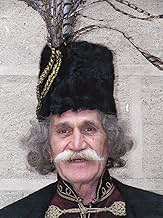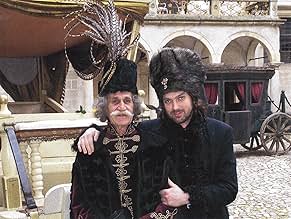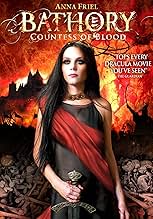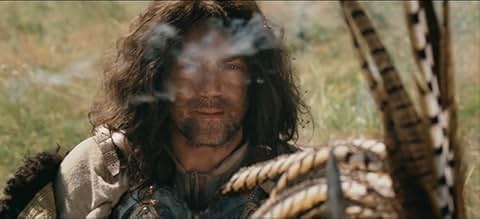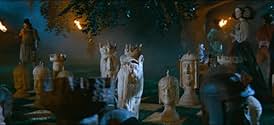IMDb-BEWERTUNG
5,7/10
4806
IHRE BEWERTUNG
Mit ihrem unstillbaren Blutdurst war die Gräfin Elizabeth Bathory eine der produktivsten Serienmörderinnen der Geschichte.Mit ihrem unstillbaren Blutdurst war die Gräfin Elizabeth Bathory eine der produktivsten Serienmörderinnen der Geschichte.Mit ihrem unstillbaren Blutdurst war die Gräfin Elizabeth Bathory eine der produktivsten Serienmörderinnen der Geschichte.
- Regie
- Drehbuch
- Hauptbesetzung
- Auszeichnungen
- 5 Gewinne & 4 Nominierungen insgesamt
Deana Horváthová
- Darvulia
- (as Deana Jakubisková-Horváthová)
Jaromír Nosek
- Miklós Zrínyi
- (as Míra Nosek)
Empfohlene Bewertungen
Redbox got rights to this 2008 reject from Czech TV, and melted it down into a 3 hour movie that they tried to pass off with a horror sub-title, "Countess of Blood".
Instead, what you get is a Hungarian History lesson that is about as clear as Goolash. They take the notorious Blood Countess of Hungary, Erzabet Bathory, who was one of the influences for Dracula, and actually try to spin her in a positive light (Namely, that if she was brutal at all, she was brutal for the time she lived in.) A tighter, shorter movie would have worked better, without the unneeded characters like the two monks who come up with wacky steam-punk inventions.
I think the movie looks great and puts you in that time period pretty well... and it quickly touches on the politics of feudal Austria-Hungary. But it's really just too long and unfocused.
Instead, what you get is a Hungarian History lesson that is about as clear as Goolash. They take the notorious Blood Countess of Hungary, Erzabet Bathory, who was one of the influences for Dracula, and actually try to spin her in a positive light (Namely, that if she was brutal at all, she was brutal for the time she lived in.) A tighter, shorter movie would have worked better, without the unneeded characters like the two monks who come up with wacky steam-punk inventions.
I think the movie looks great and puts you in that time period pretty well... and it quickly touches on the politics of feudal Austria-Hungary. But it's really just too long and unfocused.
This story follows the rise and fall of one of history's most prolific serial killers, Countess Báthory who supposedly bathed in virgins blood to stay youthful.
This is a comprehensive fictionalised TV version directed and written by Juraj Jakubisko with mixed production values in both tone and atmosphere. The setting is fantastic and breathtaking, however, the exterior scenes lack the Gothic feel that the interiors have.
As a TV film, in several parts, the Monks narration and involvement arguably fits, however, as a film it may have benefited from the omission of the character entirely. You'll also either love or hate the involvement of painter Caravaggio. Historical inaccuracies aside and the unnecessary humour injected usually by the monk, this incarnation of the legend is very interesting and adds food for thought to the tale of Báthory. In addition, it gives an interesting portrayal of politics, religion and royalty of the time.
Anna Friel is fantastic as the miss-judged Erzsébet Báthory and gives a wonderful performance, full of range and emotional depth. It's not all out horror, a possible nod to Ingrid Pitt in Countess Dracula (1970). Co-Star Karel Roden is on top form as Juraj Thurzo and Vincent Regan is notable. The supporting cast do just that. The principle characters have strong motivations for their actions and the morale choices are at times shades of grey.
It's not without its faults but there's a handful of interesting dream and hallucination sequences and enough twists on the tale to keep you watching. This coupled with some fine locations, costumes and performances makes Bathory worth your time.
This is a comprehensive fictionalised TV version directed and written by Juraj Jakubisko with mixed production values in both tone and atmosphere. The setting is fantastic and breathtaking, however, the exterior scenes lack the Gothic feel that the interiors have.
As a TV film, in several parts, the Monks narration and involvement arguably fits, however, as a film it may have benefited from the omission of the character entirely. You'll also either love or hate the involvement of painter Caravaggio. Historical inaccuracies aside and the unnecessary humour injected usually by the monk, this incarnation of the legend is very interesting and adds food for thought to the tale of Báthory. In addition, it gives an interesting portrayal of politics, religion and royalty of the time.
Anna Friel is fantastic as the miss-judged Erzsébet Báthory and gives a wonderful performance, full of range and emotional depth. It's not all out horror, a possible nod to Ingrid Pitt in Countess Dracula (1970). Co-Star Karel Roden is on top form as Juraj Thurzo and Vincent Regan is notable. The supporting cast do just that. The principle characters have strong motivations for their actions and the morale choices are at times shades of grey.
It's not without its faults but there's a handful of interesting dream and hallucination sequences and enough twists on the tale to keep you watching. This coupled with some fine locations, costumes and performances makes Bathory worth your time.
A long, rambling, shambling, doddering, staggering chaos of a film, blighted by (amongst other things): (1) impenetrable Middle European accents, most of them genuine but three put on ~ by Miss Friel, her husband, and her lover; (2) a narrative style that was very much like listening to a boring drunk recounting a shaggy dog story; (3) a schizoid attitude toward the countess herself ~ ambiguity is all very well, but to switch sides several times in the course of one story just makes the storyteller appear 'flakey'; (4) a sub-plot about two spying monks which ... well, which beggared description in its absurdity; (5) visual imagery and editing which frequently resembled pop videos; (6) so on and so forth.
Lavish, romanticized account of the life and times of 16th century Hungarian countess Erzsébet Bathory, history's most prolific serial killer...
BATHORY, a would-be epic with nice period detail, aspires to myth-buster status by painting the "Bloody Countess of Čachtice" as a victim of political chicanery in a male-dominated society but all it accomplishes is a "legend" of its own by white-washing history, facts be damned. Here, as a wealthy woman who's vast holdings could turn the tide in a power struggle between Catholics and Protestants as they fight off a Muslim invasion, Countess Bathory is more sinned against than sinning and framed for crimes she never committed. Yeah, right. Valentine Penrose & Alexander Trocchi's well-researched "The Bloody Countess: Atrocities Of Erzsébet Bathory", offers a significantly different account based on historical records:
"Descended from one of the most ancient aristocratic families of Europe, Erzsébet Bathory bore the psychotic aberrations of centuries of intermarriage. From adolescence she indulged in sadistic lesbian fantasies where only the spilling of a woman's blood could satisfy her urges. By middle age she had regressed to a mirror-fixated state of pathological necro-sadism involving witchcraft, torture, blood-drinking, cannibalism and, inevitably, wholesale slaughter. These years, at the latter end of the 16th century, witnessed a reign of cruelty unsurpassed in the annals of mass murder with the Countess' depredations on the virgin girls of the Carpathians leading to some 650 deaths. Her many castles were equipped with chambers where she would hideously torture and mutilate her victims, becoming a murder factory where hundreds of girls were killed and processed for the ultimate youth-giving ritual: the bath of blood..."
In Juraj Jakubisko's film, Erzsébet Bathory is depicted as an intelligent woman ahead of her time and a Protestant preyed upon by the Catholic Church as well as her late husband's covetous best friend although she still finds time for a passionate affair with the Italian painter Caravaggio (!) as her subjects try inventing spring-powered roller skates, phonographs, still photography, and primitive airplanes a la Leonardo Da Vinci. The tale, a de-fanged poison valentine to renaissance Hungary, is served up on a grand scale but twists the truth into a monumental mis-carriage of injustice that's recommended to revisionists only. What's next, JEFFREY DAHMER -THE MUSICAL?
BATHORY, a would-be epic with nice period detail, aspires to myth-buster status by painting the "Bloody Countess of Čachtice" as a victim of political chicanery in a male-dominated society but all it accomplishes is a "legend" of its own by white-washing history, facts be damned. Here, as a wealthy woman who's vast holdings could turn the tide in a power struggle between Catholics and Protestants as they fight off a Muslim invasion, Countess Bathory is more sinned against than sinning and framed for crimes she never committed. Yeah, right. Valentine Penrose & Alexander Trocchi's well-researched "The Bloody Countess: Atrocities Of Erzsébet Bathory", offers a significantly different account based on historical records:
"Descended from one of the most ancient aristocratic families of Europe, Erzsébet Bathory bore the psychotic aberrations of centuries of intermarriage. From adolescence she indulged in sadistic lesbian fantasies where only the spilling of a woman's blood could satisfy her urges. By middle age she had regressed to a mirror-fixated state of pathological necro-sadism involving witchcraft, torture, blood-drinking, cannibalism and, inevitably, wholesale slaughter. These years, at the latter end of the 16th century, witnessed a reign of cruelty unsurpassed in the annals of mass murder with the Countess' depredations on the virgin girls of the Carpathians leading to some 650 deaths. Her many castles were equipped with chambers where she would hideously torture and mutilate her victims, becoming a murder factory where hundreds of girls were killed and processed for the ultimate youth-giving ritual: the bath of blood..."
In Juraj Jakubisko's film, Erzsébet Bathory is depicted as an intelligent woman ahead of her time and a Protestant preyed upon by the Catholic Church as well as her late husband's covetous best friend although she still finds time for a passionate affair with the Italian painter Caravaggio (!) as her subjects try inventing spring-powered roller skates, phonographs, still photography, and primitive airplanes a la Leonardo Da Vinci. The tale, a de-fanged poison valentine to renaissance Hungary, is served up on a grand scale but twists the truth into a monumental mis-carriage of injustice that's recommended to revisionists only. What's next, JEFFREY DAHMER -THE MUSICAL?
Many reviews here find the monks' humor out of place, inappropriate, or they just didn't see the purpose of it. It's my opinion that if you didn't find it amusing, then its most likely more of a cultural difference than a matter of taste. This type of humor is very common in Slovakia and Romania. I'm saying this as a Slovak-American, someone married to a Romanian, and who lived in Romania for five years.
I also agree with the reviewers who point out this is a post-modernist historical fiction. It's more of a fantasy than either a horror tale or historical biography.
Yes, there are some flaws with the point-of-view at the beginning. The first part was disjointed because it kept switching plot lines and character focus, but the second and third parts worked magically. I'm sure it also seemed complex or confusing if you are not familiar with the inner struggles and politics of the Hungarians, Slovaks, and Romanians at that time. But, I find it interesting and even amusing that the conflicts still continue within these reviews about whose version of history is right (or best) -- the Hungarian Catholics, the Lutherans, the Slovaks, the Romanians in Transylvania, etc. That's basically the point of the movie! We'll never know the "truth" unless we could have had some spies there writing it all down in a record that also verified the other evidence. Every noble family and religion in that space has always had political power motives in presenting their own versions of history. It gets so crazy and sad at a point that all you can do is make a joke (like the monks) and try to laugh so you don't go crazy too.
I also agree with the reviewers who point out this is a post-modernist historical fiction. It's more of a fantasy than either a horror tale or historical biography.
Yes, there are some flaws with the point-of-view at the beginning. The first part was disjointed because it kept switching plot lines and character focus, but the second and third parts worked magically. I'm sure it also seemed complex or confusing if you are not familiar with the inner struggles and politics of the Hungarians, Slovaks, and Romanians at that time. But, I find it interesting and even amusing that the conflicts still continue within these reviews about whose version of history is right (or best) -- the Hungarian Catholics, the Lutherans, the Slovaks, the Romanians in Transylvania, etc. That's basically the point of the movie! We'll never know the "truth" unless we could have had some spies there writing it all down in a record that also verified the other evidence. Every noble family and religion in that space has always had political power motives in presenting their own versions of history. It gets so crazy and sad at a point that all you can do is make a joke (like the monks) and try to laugh so you don't go crazy too.
Wusstest du schon
- WissenswertesFamke Janssen was originally signed on for the part of Bathory, but for reasons unknown she backed out. Anna Friel read the script and fell in love with it and sent the director a letter convincing him to cast her. It was written in Slovak language, because her babysitter was from Slovakia and helped her writing it.
- VerbindungenReferenced in Vsechnopárty: Folge vom 24. Juni 2008 (2008)
Top-Auswahl
Melde dich zum Bewerten an und greife auf die Watchlist für personalisierte Empfehlungen zu.
- How long is Bathory: Countess of Blood?Powered by Alexa
Details
- Erscheinungsdatum
- Herkunftsländer
- Sprache
- Auch bekannt als
- Bathory - Die Blutgräfin
- Drehorte
- Produktionsfirmen
- Weitere beteiligte Unternehmen bei IMDbPro anzeigen
Box Office
- Weltweiter Bruttoertrag
- 7.005.528 $
- Laufzeit
- 2 Std. 21 Min.(141 min)
- Farbe
- Sound-Mix
- Seitenverhältnis
- 2.35 : 1
Zu dieser Seite beitragen
Bearbeitung vorschlagen oder fehlenden Inhalt hinzufügen



